By Peter J. Nash
March 25, 2013
|
Image may be NSFW. Clik here to view.  Albert G. Spalding's genuine signature is found on letters stolen from the NYPL collection bearing his name. |
There’s no shortage of genuine exemplars of handwriting available for so-called experts to authenticate signatures of Hall of Fame pitcher and nineteenth century sporting goods magnate Albert Goodwill Spalding. In most of our reports Spalding’s name is linked to the infamous thefts from his magnificent baseball collection housed at the Fifth Avenue branch of the New York Public Library in New York City. Some of the items stolen from that collection include handwritten letters sent to his friend and associate, Harry Wright, who served as his manager and mentor when he played for the Boston Red Stockings in the early 1870s.
Wright’s diaries, account books, correspondence and scrapbooks were the cornerstone of Spalding’s collection and over the years have been the target of thieves who have raided assorted volumes and manuscript pages for autographs and valuable ephemera. Just this week a page that was torn and wrongfully removed from Wright’s account books housed at the NYPL appeared for sale at Premier Auctions in Arizona and went for a hammer price of $1,099. (The same stolen ledger page sold at RR Auctions in 2009 for over $1,000 and was described by Steve Grad of PSA/DNA as being written in a different hand but signed by Wright). The NYPL inventory of the Spalding Manuscript collection conducted in 1986 and 2005 shows that the collection’s Wright “Note and Account Books 1860-1893″ have three volumes missing and many pages of the surviving volumes have been vandalized. NYPL’s Brook Astor Director of Collections Strategy, Victoria Steele, did not return calls for comment on the sale of the manuscript page, which was actually written (and signed) entirely in Harry Wright’s hand.
Clik here to view.

Premier Auctions in Arizona is offering this account ledger page (left) with Harry Wright's autograph in its current auction; The vandalized page originated from the NYPL's Harry Wright Note and Account Books archive which was listed in a 1986 inventory (right).
The stolen NYPL items extend to handwritten letters penned by Albert Spalding to Wright which have also been sliced and diced out of voluminous scrapbooks created by library officials when they received Harry Wright’s correspondence collection as part of a donation from Spalding’s widow in 1921. Two extremely significant Spalding letters have been sold in the last decade at auction and are, no doubt, missives wrongfully removed from one of the four scrapbooks of Wright’s personal correspondence that used to sit on the shelves of the rare books and manuscripts division of the library. Collector Barry Halper was the mastermind of the library heist and as early as 1977 he was showing off his stolen treasures to sportswriter Bill Madden on the pages of The Sporting News. In 2009 a “cache of rare letters” from the Wright correspondence collection appeared for sale at MLB’s FanFest auction and an FBI investigation was commenced.
Five years earlier, in 2004, four-page letter written to Wright by Spalding from London while the Boston Red Stockings team was traveling on a world tour, appeared for sale at Robert Edward Auctions in Watchung, New Jersey. Auctioneer Rob Lifson’s lot description described the letter as:
“….a most extraordinary letter, with substantial content, from Al Spalding to Harry Wright, and with reference to Henry Chadwick, written during the first baseball World Tour of 1874. All writing is perfectly immaculate and neat. The letter is in Near Mint condition, with signature and all writing grading “10.” One of the most historically significant of all nineteenth-century baseball letters. LOAs from Mike Gutierrez/GAI and James Spence & Steve Grad/PSA DNA.”
Of course the letter was found to be authentic by the alleged experts James Spence and Steve Grad, as it was once part of Harry Wright’s personal archive housed at the library in volume 1 of the Wright Correspondence scrapbooks. Lifson didn’t mention that fact in his lot description or the fact that the reverse of the last page exhibited evidence of having been once adhered to a scrapbook page. Still, the authenticators had four full pages of Spalding’s actual authentic handwriting to examine and also file away in their exemplar files for future authentications.
Clik here to view.

This authentic 4-page letter written in 1874 by Spalding to Harry Wright was stolen from the NYPLs Spalding Collection and sold for close to $25,000 in a 2004 Robert Edward Auctions sale.
At the same time the REA Spalding letter was being sold another appeared on the market in a Mike Gutierrez auction that was also addressed to Wright and dated from New Years Eve, 1877 (and also originating from NYPL Wright scrapbook Vol. 1).
That Spalding letter, which deals with early issues related to club memberships in the recently formed National League, was authenticated by Mike Gutierrez of MG Auctions and an outfit named “Global Authentication.”
Clik here to view.
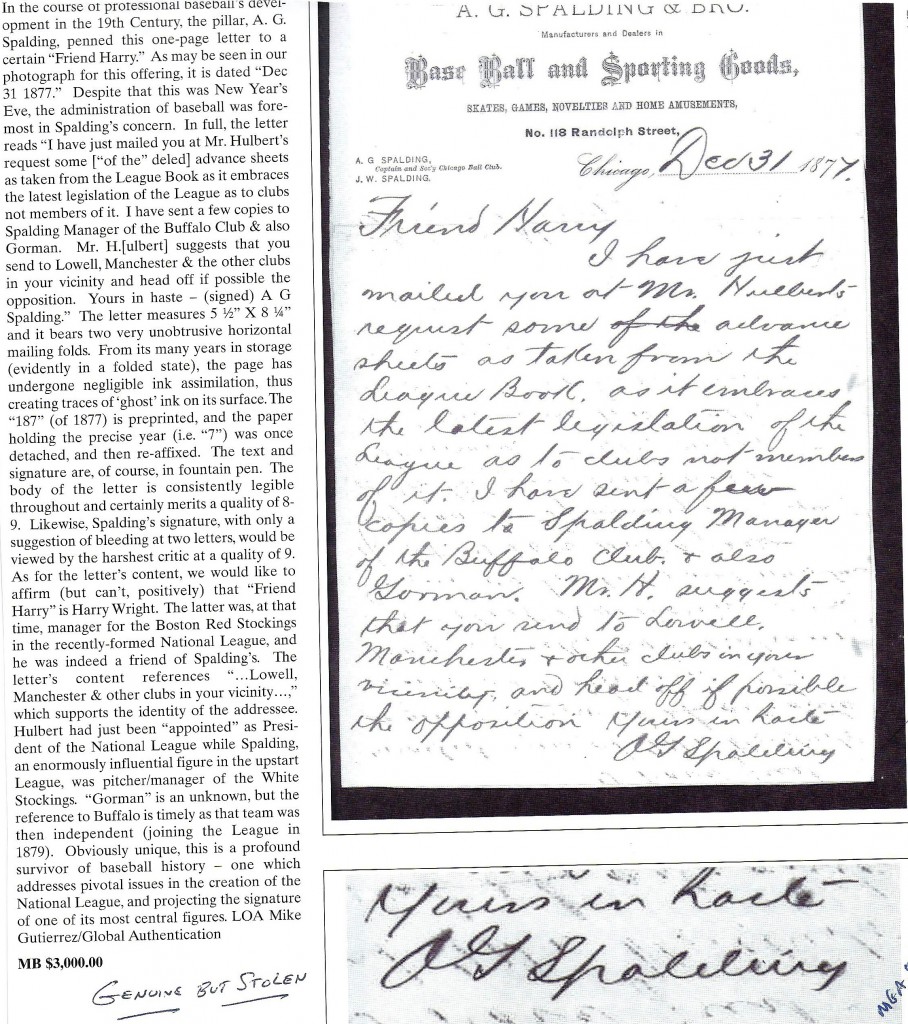
This page from a 2004 Mike Gutierrez auction catalog shows the sale of another Spalding letter stolen from the NYPLs Spalding Collection. The letter is also addressed to Harry Wright and discusses National League issues for the 1878 season on New Years Eve, 1877.
In May of 2006, Lifson and REA offered another authentic letter written by Spalding in 1900 and sent to Hall of Famer Henry Chadwick. (This letter was not stolen from the NYPL Wright archive, rather purchased by this writer directly from the great-great-grandchildren of Henry Chadwick.) REAs lot description included this passage about the letter and its authentication:
“Extremely significant content on many counts, especially in light of Spalding’s dream to have baseball represented in the Olympics, and his long-standing desire to spread the gospel of baseball throughout the world. LOAs from James Spence/JSA and Steve Grad, Mike Gutierrez & Zach Rullo/PSA DNA.”
The letter is proof positive that Steve Grad of PSA/DNA and other authenticators like Gutierrez and James Spence had examined and possessed authentic exemplars of Spalding’s genuine handwriting in their exemplar files– several handwritten letters spanning from the 1870s to the turn of the 20th century.
Clik here to view.
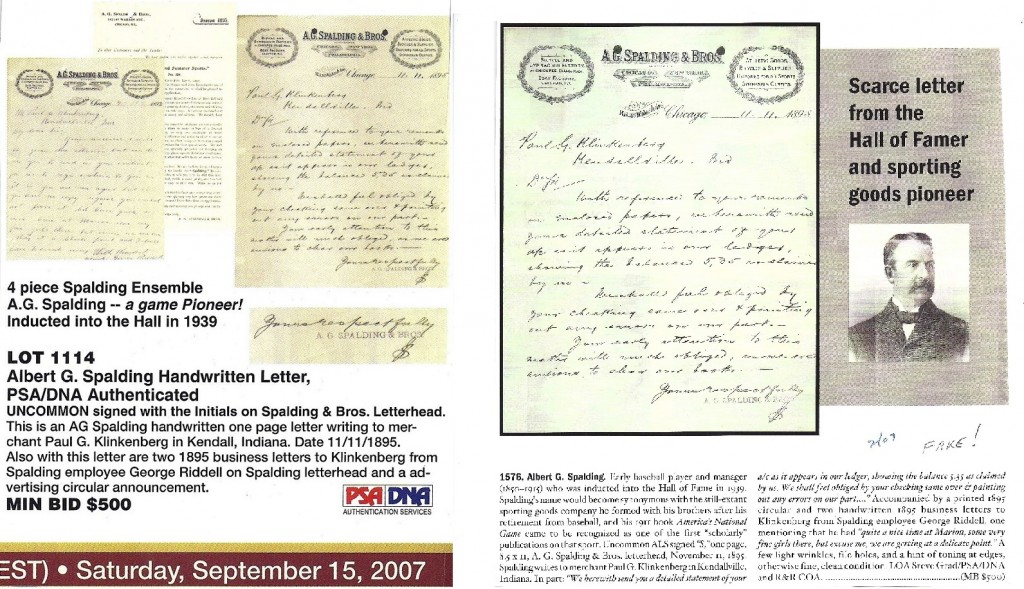
A letter written by a Spalding employee (and not AG Spalding) was sold at Memory Lane Auctions (left) and RR Auctions (right) in 2007 with an LOA from Steve Grad and PSA certifying it as authentic.
The fact that Steve Grad, in particular, had these exemplars in his possession makes a recent discovery made by autograph expert Steve Koschal quite remarkable. While rummaging through some old exemplar files, Koschal came across a few Spalding entries including the 2004 Gutierrez offering and another that appeared in a February, 2007, auction conducted by RR Auctions and described as a handwritten letter penned by Spalding on A.G Spalding & Brothers sporting goods stationary. RR said the letter was dated on November 11, 1895 and addressed to a Kendallville, Indiana, merchant stating:
“We herewith send you a detailed statement of your a/c as it appears in our ledger showing the balance of 5.35 as claimed by us. We shall feel obliged by your checking same over and pointing out any errors on our part.”
The auction house said the letter was signed “S” and was accompanied by an LOA from Steve Grad and PSA/DNA and another from RR Auctions. Neither the auction house nor the authenticators bothered to consider the likelihood that magnate A. G. Spalding, who had already by 1895 placed his brother James at the helm of the sporting goods company, would be sending handwritten collection letters for $5.35 to small town merchants in Indiana. He wouldn’t have. If Steve Grad and PSA had examined the document utilizing the exemplars of authentic Spalding letters they had already issued LOAs for in previous auction sales, the 1895 letter would have been rejected and readily identified as a fraudulent attempt to pass off a generic Spalding company letter as a gem signed by Spalding himself. Grad, however, did have access to the authentic documents, which makes this situation more problematic and indicative of how PSA/DNA and auction houses conduct business.
Clik here to view.
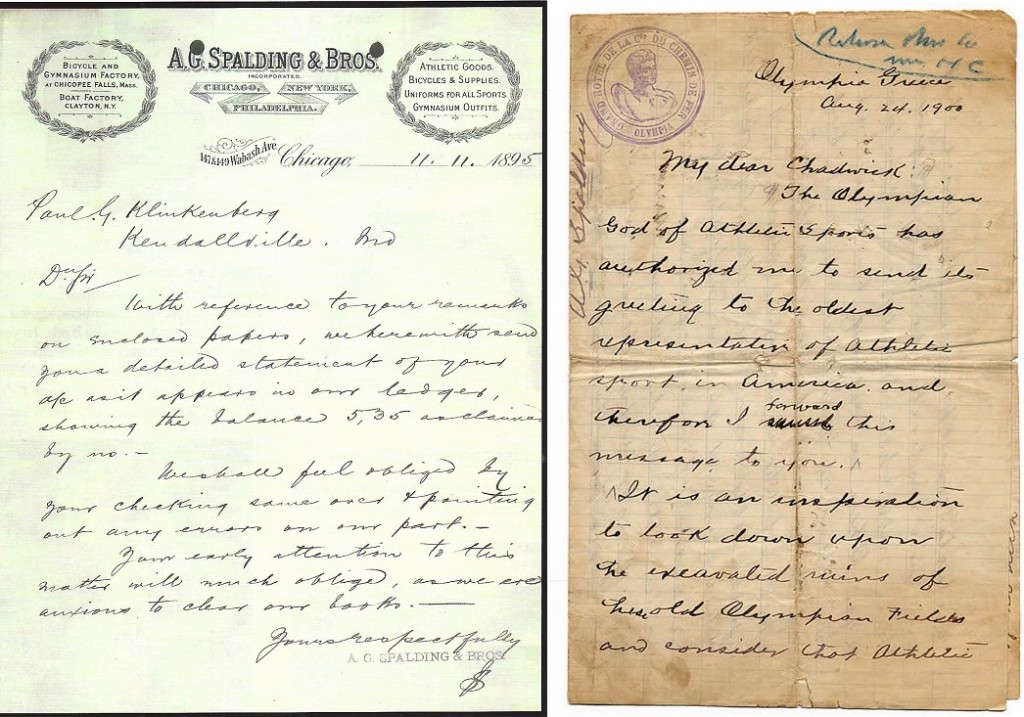
The letter LOAd as a genuine Spalding, although it was actually written by a Spalding employee in 1895 (left), contrasts a genuine letter written by Spalding in 1900 (right).
We’re not sure what the letter sold for at RR Auctions but incredibly the letter (and accompanying ephemera) appeared just seven months later in a Memory Lane auction as lot 1114 and sold for $947.05, considerably less than an authentic Spalding letter should have sold for. Memory Lane posted the PSA/DNA logo alongside images of the bogus letter described as “Albert G. Spalding Handwritten Letter, PSA/DNA Authenticated.”
There are so many reasons, aside from handwriting, that rule this document out as an authentic Spalding letter, however, when the actual handwriting itself is compared against genuine specimens, Grad and PSA/DNAs letters of authenticity can be summarily dismissed as fraudulent instruments that transformed a relatively worthless piece of paper into a liquid asset. This situation, however, is not an isolated incident as PSA/DNA and Grad have continued authenticating Spalding forgeries as authentic including a recent offering encapsulated in a PSA/DNA holder.
Clik here to view.

An alleged Spalding autograph was encapsulated and authenticated by Grad and PSA/DNA (top) despite the fact the handwriting exhibits all of the traits of a forgery when compared to an authentic inscribed copy of Spalding's 1911 book, America's National Game (Bottom). We believe the forger used this authentic example (once in the Barry Halper Collection) as his guide. The key is how he attempted to replicate the word "Loma" which appears to be the product of a problem with Spalding's original pen.
Steve Verkman and Clean Sweep Auctions in January featured what appeared to be a cut and inscribed page bearing what was advertised as Spalding’s signature sealed in a plastic tomb created by PSA and marked “Cut-Albert Spalding PSA/DNA Certified.” Clean Sweep called it a “true 3×5″ and made no mention of Spalding’s book from 1911, however, if this item is compared against an actual authentic inscribed copy of Spalding’s 1911 book it becomes quite apparent that PSA/DNA has certified yet another Spalding forgery. The slabbed signature sold for $3,302, but when compared to scores of other authentic exemplars written by Spalding in inscribed copies of his book presented as Christmas gifts for his friends and colleagues in December of 1911. The Clean Sweep offering is a fairly well-executed forgery but exhibits evidence of being copied and patterned directly from an authentic exemplar from the 1911 book which was once part of the Barry Halper Collection (see illustration). PSA should have realized this because they actually have two additional authentic examples of Spalding signed books dated from December of 1911 on its “Autograph Facts” page.
Clik here to view.
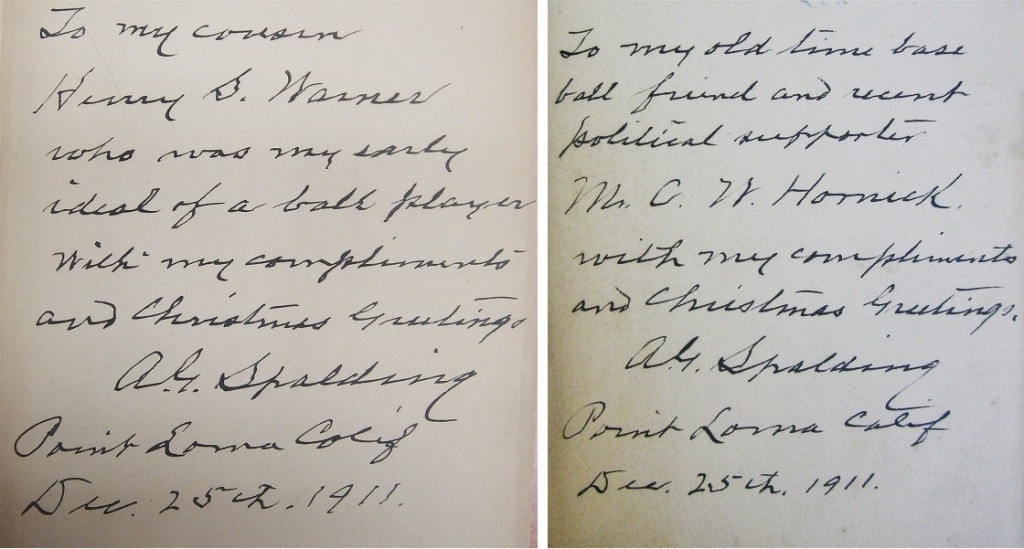
In stark contrast to the PSA encapsulated Spalding inscription sold at Clean Sweep are two authentic Spalding exemplars actually signed by Spalding in December of 1911. These two exemplars appear on PSA's "Autograph Facts" page.
In 2004, Grad and PSA even published a study of Spalding’s handwriting and correctly noted the tremulous characteristics found on exemplars written during the last decade of his life. PSA and Grad wrote:
“From his early days in the league until his demise, Spalding’s right hand penned his name carefully and slowly. His earlier signature was rounder, larger and more ostentatious in Spencerian style capitalization, often using all the letters in his first name. Most of what survived are sharp jagged examples, from the last decade of his life, that exhibit motor skill deterioration, having been effected by a series of strokes. His upper case “AG” is an unbroken line construction with a conventional “A” extending the (sometimes elongated) connector into the single upper loop “G”. This character seems oddly unfinished with its terminal stoke darting vertically downward, punctuated arbitrarily on either side of this stroke.”
Clik here to view.
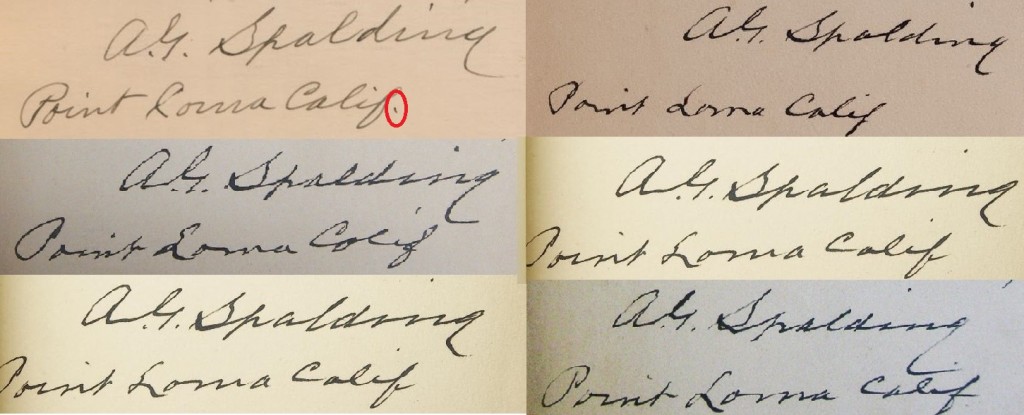
The Spalding PSA-authenticated forgery (top left) not only clashes with the handwriting exhibited on five other authentic Spalding inscriptions signed in 1911, it also includes a period placed after the abbreviation "Calif". It appears the forger may have given himself away here as well with this period placement.
The encapsulated Spalding signature exhibits hesitations and stoppages that are characteristic of a forgery and lacks the uniformity of what PSA correctly identified in their study as the “sharp, jagged examples from the last decade of (Spalding’s) life.” The most striking deficiency in the PSA certified forgery is the absence of these very sharp and angular strokes that define Spalding’s handwriting at this period in his life. The forgery lacks the natural flow of Spalding’s handwriting and the contrast is most apparent when the forgery stands next to the five genuine examples in our illustration.
In addition, we noticed that the forger may have made a critical mistake that also gave him away; the forged and slabbed signature includes a period placed after Spalding’s abbreviated “Calif.” We examined at least ten authentic inscribed and signed Spalding books with the “Point Loma” inscription and none of them included punctuation after the “Calif” abbreviation. Only the PSA authenticated forgery included a period.
Most collectors would be fooled by this decent forgery which is a great example to illustrate how a forger can replicate a signature and convince an alleged expert it is genuine. Of course it “looks like” a genuine Spalding, that’s what the forger is trying to achieve. However, when analyzed closely it is exposed that it only mimics an authentic signature and shows evidence of another hand, that of the forger. At least the slabbed Spalding actually looked like Spalding’s scrawl, whereas the 1895 Spalding company letter exhibited virtually no resemblance to Spalding’s actual handwriting.
Ron Keurajian examined the PSA-certed Spalding forgery and referred us to his book, Baseball Hall of Fame Autographs: A Reference Guide, and his section devoted to Albert G. Spalding. In his study, Keurajian states that authentic examples of the 1911 Spalding book “are a fine source of Spalding signatures” but stresses that, “Due to the slower nature of his hand, Spalding’s signature from any era of his life, is easily replicated.” Keurajian adds, “Well executed forgeries exist in quantity, so caution is warranted. Most of the Spalding signatures in the market are forgeries.”
That would include these two misrepresented Spalding forgeries authenticated by Steve Grad and PSA/DNA.